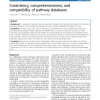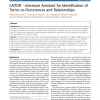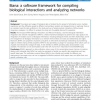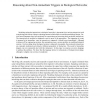BMCBI
2008
13 years 11 months ago
2008
Background: Clustering is a popular data exploration technique widely used in microarray data analysis. Most conventional clustering algorithms, however, generate only one set of ...
BMCBI
2010
13 years 11 months ago
2010
Background: The amount of available biological information is rapidly increasing and the focus of biological research has moved from single components to networks and even larger ...
BMCBI
2010
13 years 11 months ago
2010
Background: It is necessary to analyze microarray experiments together with biological information to make better biological inferences. We investigate the adequacy of current bio...
BMCBI
2010
13 years 11 months ago
2010
Background: Biological knowledge is represented in scientific literature that often describes the function of genes/ proteins (bioentities) in terms of their interactions (biointe...
BMCBI
2010
13 years 11 months ago
2010
Background: The analysis and usage of biological data is hindered by the spread of information across multiple repositories and the difficulties posed by different nomenclature sy...
BMCBI
2010
13 years 11 months ago
2010
Background: Co-evolution is the process in which two (or more) sets of orthologs exhibit a similar or correlative pattern of evolution. Co-evolution is a powerful way to learn abo...
BIODATAMINING
2008
13 years 11 months ago
2008
The analysis and interpretation of relationships between biological molecules, networks and concepts is becoming a major bottleneck in systems biology. Very often the pure amount ...
AMAI
2007
Springer
13 years 11 months ago
2007
Springer
Modeling molecular interactions in biological networks is important from various perspectives such as predicting side effects of drugs, explaining unusual cellular behavior and dr...
CSWWS
2006
14 years 3 months ago
2006
Bioinformaticians are accustomed to going through analysis steps, in which they employ several data sources, like protein sequence and protein interaction databases, to carry out t...
GCB
2009
Springer
14 years 3 months ago
2009
Springer
: Understanding complex biological systems requires data from manifold biological levels. Often this data is analysed in some meaningful context, for example, by integrating it int...







